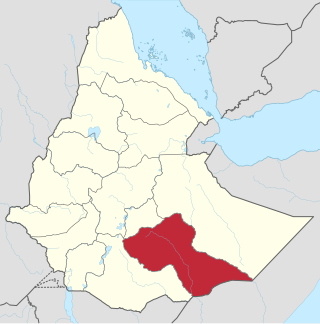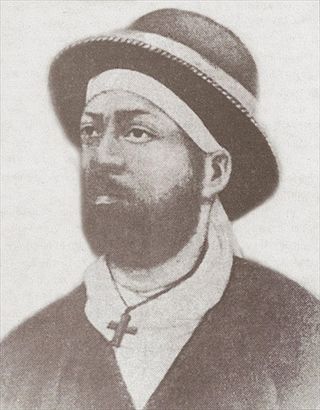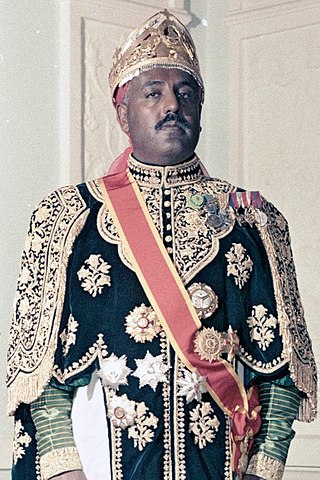Related Research Articles

Menelik II, baptised as Sahle Maryam was king of Shewa from 1866 to 1889 and Emperor of Ethiopia from 1889 to his death in 1913. At the height of his internal power and external prestige, the process of territorial expansion and creation of the modern empire-state was completed by 1898.

The Solomonic dynasty, also known as the House of Solomon, was the ruling dynasty of the Ethiopian Empire from the thirteenth to twentieth centuries. The dynasty was founded by Yekuno Amlak, who overthrew the Zagwe dynasty in 1270. His successors claimed he was descended from the legendary king Menelik I, the supposed son of the biblical King Solomon and the Queen of Sheba, in order to legitimize the dynasty's assumption of power. Although this claimed ancestry gave the dynasty its name, there is no credible evidence that the dynasty was descended from Solomon or the Davidic line. The Solomonic dynasty remained in power until 1974, when its last emperor Haile Selassie was overthrown by a coup d'état.

Bale, also known as Bali, is the name of a former polities located in the southeastern part of modern Ethiopia. It bordered the Dawaro to the north, Hadiya in the west, and Adal in the east and its core areas were located around the Shebelle River. However, the borders of Bale during the medieval period are unclear - it is usually placed around the Wabe Shebelle river, another river that shaped its borders was the Wabe River. Overall, borders of historical Bale corresponded to the modern districts of Goba, Sinana-Dinsho, Agarfa, Gasera and Goro. In the 14th century it was located between Ifat and Solomonic tributary state of Hadiya. Taddesse Tamrat locates Bale south of the Shebelle River, which separated the kingdom from Dawaro to the north and Adal to the northeast; Richard Pankhurst adds that its southern boundary was the Ganale Dorya River. Ulrich Braukämper, after discussing the evidence, states that this former dependency "occupied an area in the northeast of the province which later was named after it, between the mountain range of Urgoma and the eastern Wabi Bend."

Hailemelekot Sahle Selassie was Negus of Shewa, a historical region of Ethiopia, from 12 October 1847 until his death. He was the oldest son of Negus Sahle Selassie an important Amhara noblemen and his wife Woizero Bezabish Wolde.

Tekle Giyorgis II was Emperor of Ethiopia from 1868 to 1871. After being crowned, he linked himself to the last independent emperors of the Gondar line through his mother and sought support from the Ethiopian Church to strengthen his right to rule. He was wounded when fighting during the 1871 Battle of Adwa, leading to the demoralization of his troops and capture of him and his generals and later on his death in captivity.

Mentewab was Empress of Ethiopia, consort of Emperor Bakaffa, mother of Iyasu II and grandmother of Iyoas I. She was also known officially by her baptismal name of Walatta Giyorgis. Mentewab was a major political figure during the reigns of her son the Emperor Iyasu and grandson Iyoas. Empress Mentewab was also known by the honorific of Berhan Mogassa. This was to complement the honorific of her son Iyasu II, who was Berhan Seged.
Ras, is a royal title in the Ethiopian Semitic languages. It is one of the powerful non-imperial titles.

Darge Sahle Selassie, Horse name Abba Gersa, was a 19th-century Ethiopian nobleman, provincial governor, general and a trusted councillor of his nephew Emperor Menelik II.
Tsehaiwork Darge was the daughter of Ras Darge Sahle Selassie, Prince of Selale, and granddaughter of Sahle Selassie, King of Shewa from 1813 to 1847.
Keb Darge is a Scottish DJ and music producer, in the genres of Northern soul, deep funk, garage punk, and rockabilly music. He is credited with inventing the term 'deep funk'.

RasKassa Hailu KS, GCVO, GBE, was a Shewan Amhara nobleman, the son of Dejazmach Haile Wolde Kiros of Lasta, the ruling heir of Lasta's throne and younger brother of Emperor Tekle Giyorgis II, and Tisseme Darge, the daughter of Ras Darge Sahle Selassie, brother of Menelik II's father.
Darge is a surname. Notable people with the surname include:
Hailu Tekle Haymanot, also named Hailu II of Gojjam, was an army commander and a member of the nobility of the Ethiopian Empire. He represented a provincial ruling elite who were often at odds with the Ethiopian central government. Hailu Tekle Haymanot was an independent-minded potentate who, throughout his life, was mistrustful of and mistrusted by the Emperor.
Aberra Kassa was an army commander and a member of the Royal family of the Ethiopian Empire.
Asfawossen Kassa was an army commander and a member of the royal family of the Ethiopian Empire.

Colias electo, the African clouded yellow or lucerne butterfly, is a butterfly of the family Pieridae. It is found in eastern and southern Africa, as well as Arabia. The habitat consists of temperate and montane grasslands.
Jardega Jarte is one of the woredas in the Oromia Region of Ethiopia. It was part of former Amuru Jarte woreda. Part of the Horo Gudru Welega Zone it is bordered on the east by Abay Chomen, on the south by Horo, on the southwest by Abe Dongoro, on the west by East Welega Zone, on the northwest by Amuru on the north by the Abay River which separates it from the Amhara Region, and on the east by Abay Chomen. The administrative center is Alibo. The other town in this district is jardega . The large field which is called Jarmet is found in this district. and the other historical place is Oda Wixar which is found in Darge Koticha Kebele.The district is known for its cattle, crop productivity and production of honey. Also in some Kebeles such as Derge koticha, Harbu Negaso, Kiltu Cheka, Digalu,Wato and others production of coffee, fruits and vegetables is common.

LeulRasAserate KassaGCVO was a Viceroy of Eritrea and a member of the nobility of the Ethiopian Empire. He was the fourth son of Ras Kassa Haile Darge, and his wife Princess (Le'ilt) Tsige Mariam Beshah. Prince Aserate Kassa was educated at Monkton Combe School in the United Kingdom between 1937 and 1938. He was married to (Le'ilt) Zuriashwork Gebre-Igziabiher, daughter of Jantirar Gebre-Igziabiher, and granddaughter of Empress Menen Asfaw, consort of Emperor Haile Selassie I. Prince Aserate Kassa was the head of the Selalle sub-branch of the Shewan branch of Ethiopia's Imperial Solomonic dynasty.
The Battle of Azule was fought on 6 September 1886, between the forces of Ras Darge Sahle Selassie of Shewa and a force of Arsi Oromo. It was part of a broader series of expansion campaigns done under Menelik II, Negus of Shewa, referred to by some historians as the Agar Maqnat. The battle of Azule was important as it represents the crushing of a large Arsi army by one under Menelik; it also demonstrates the dynamic of gun-wielding Shewans fighting Spear-wielding Arsi that many historians like to stress when discussing Menelik's expansions; it also retains symbolic and historic importance in the politics and identities of many.
References
- ↑ "Interwar, Middle East, CASSA, 1936". collectionswa.net.au. Retrieved 2024-01-19.
- ↑ Sereke-Brhan, Heran (2005). ""Like Adding Water to Milk": Marriage and Politics in Nineteenth-Century Ethiopia". The International Journal of African Historical Studies. 38 (1): 49–77. ISSN 0361-7882. JSTOR 40036463.
- ↑ Prouty, Chris (1986). Empress Taytu and Menilek II: Ethiopia, 1883-1910. Red Sea Press. pp. 221–222. ISBN 0-947895-01-9.